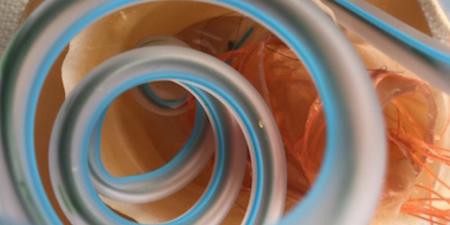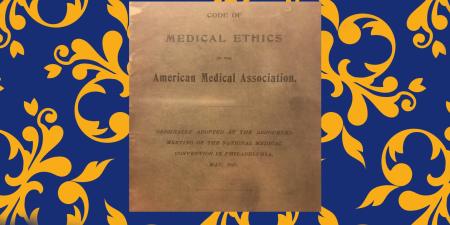Abstract
This case describes a patient with advanced dementia and an unrealistic spouse, presenting an apparent dilemma about nutrition for physicians. By eliciting the perspective of the caregiver, the physicians can gain insight and rebuild trust that protects the interests of both the patient and the spouse. Their goal needs to shift from resolving the professional ethical dilemma to affirming the immeasurable contribution of the caregiver, acknowledging her journey, asking for her advice, and enabling the work of making meaning in the time available.
Case
As part of a geriatric medicine elective in his fourth year of medical school, Thomas spends a couple of afternoons a week at a local nursing home seeing patients with the attending geriatrician, Dr. Smith. One of the patients that Thomas sees with Dr. Smith is Mindt, a 78-year-old man with a history of advanced dementia who is recovering from pneumonia. He was diagnosed approximately ten years ago and moved into the nursing home about five years ago when he experienced greater functional and cognitive decline. His wife, Nila, who is in her early 70s, lives in the community and visits him frequently. They had one son who died of a myocardial infarction about 13 years ago. Nila is the health care proxy, but since Mindt didn’t clarify his preferences for end-of-life care while he had decision-making capacity, she and his other caregivers are unsure about how to respond when Mindt’s dementia progresses to the point at which he has trouble eating. Now that he either won’t open his mouth or appears to be choking when she has been trying to feed him, it seems that the time has arrived for a critical end-of-life conversation and decision.
Nila requests a meeting with Dr. Smith to discuss her concerns about her husband’s eating. A family meeting is arranged among Nila, Dr. Smith, Thomas, and a nurse and speech-language therapist who both work closely with Mindt. During this meeting, Nila expresses that if Mindt is not eating, he won’t be able to keep up his strength, and if he can’t keep up his strength, she worries that he won’t continue to recover from pneumonia. Dr. Smith explains to Nila that appetite loss and difficulties in eating are part of the natural progression of end-stage dementia. She further explains how hospice works and suggests hospice as an approach for keeping him as comfortable as possible.
Nila expresses her disagreement with Dr. Smith and clarifies that she wants everything done to prolong Mindt’s life. She repeats that she wants to know what can be done to get him to eat more.
Dr. Smith is aware that though some patients with advanced dementia receive a percutaneous endoscopic gastrostomy (PEG) so that nutrition can be provided by a tube, this treatment is not recommended for patients with advanced dementia according to guidelines from the American Geriatrics Society because, among other reasons, it is thought that the benefits do not outweigh the burdens of a patient’s discomfort, aspiration, risk of infection, increased oral secretions, tube malfunction, and possible use of restraints [1]. Dr. Smith strives to focus the conversation on preparing for Mindt’s death and keeping him comfortable; she feels that bringing up the possibility of tube feeding could lead to his prolonged discomfort. Nila is steadfast, however, about learning more about improving his nutrition. Dr. Smith and Thomas wonder whether to pose the PEG tube as an option.
Commentary
Mindt, with his advanced dementia, and Nila, his diligent caregiver, seem to present a dilemma for the physicians. Asking when and how to advocate for a comfortable dying process in this context frames the situation in a dualistic way, as if it were a conflict between the interests of a caregiver who is persisting beyond reason, on the one hand, and the interests of the patient whose imminent finitude needs attention, on the other. Dr. Smith wonders whether to broach the topic of an intervention that might burden rather than benefit the patient simply because this desperate caregiver is unable to face her loved one’s impending death. Dr. Smith might dread the possibility that Nila’s inability to cope might cause her to become uncooperative or even hostile. In such a case, challenging or even removing a surrogate from her role because she is not acting in the best interests of the patient is an available path, but not a first choice [2]. If the resident and the team find that Mindt’s and Nila’s interests are not as divergent as they first appear, then common ground might prevail.
Context of a Decision about Nutrition
The first step in such a case is to broaden the perspective from the decision in the moment to the context that holds or surrounds it. Mindt has been chronically ill and declining for years. Nila has been his faithful caregiver throughout, but she is also his wife. These two roles have enabled her to witness his painful decline with both unparalleled intimacy and unrelenting unease and sorrow. Anger and resentment may also have been part of the picture at times [3]. Since the death of their son, perhaps Nila has had no one close enough to attest to Mindt’s changes in behavior and to the necessary adjustments and painful decisions she has been forced to make in response. Attending to Mindt’s needs most likely has constricted their social universe. All this makes for a very lonely existence for each of them as individuals and for them as a married couple.
Even as long-term caregiving is isolating for family members, it is also unpaid and poorly appreciated in US society [4, 5]. Furthermore, a high burden of care is more common among caregivers of spouses such as Nila than among caregivers who provide care to another relative [6]. While clinicians might be aware of the caregiving situation and its stressful nature, they generally fail to ask caregivers about their own needs [6]. Since his son’s death and his own illness, Mindt has represented the sum total of Nila’s immediate family. His well-being has been her main goal. When he dies, she will not only feel she has failed at maintaining his health, but also be both bereft and out of a job. It is no wonder that she is resisting the outcome that the team finds inevitable. Persons who have cared for a loved one for long periods might be unwilling to forgo cardiopulmonary resuscitation at the end of life as well [7].
Mindt and Nila’s son’s death occurred only a few years before Mindt began to show signs of the disease; Nila’s continued grief from this major loss might be playing a role in her current reactions, exacerbated by Mindt’s decreasing ability to notice or share in her grief. It would be helpful for the team to know the nature of Nila’s support system, both then and now. How has Mindt understood his disease and its progression when he was able to process this information? Caregivers should reaffirm that Mindt himself has not expressed an opinion about what should happen under the circumstances they now face. His preferences in either direction do not alter the need to attend to death’s approach, however.
Interacting with the Surrogate Decision Maker
As Dr. Smith and Thomas reflect on Nila’s position rather than the ethical dilemma facing them, they can change the story they might have been telling themselves about her [8]. If Nila has sensed a willingness on the part of the team to classify Mindt as dying, then her trust might have eroded already. The team needs to make it safe for Nila to talk about her experience with Mindt not only as the clear expert on his needs, but also as a person in her own right who is primarily responsible for his well-being. What has this journey been like for her? The team might offer appreciation for Nila’s excellent care, both before and after Mindt’s admission to this facility. Surely his decline would have been more precipitous without her ongoing attention. “It must be hard for you to see him like this” is a plausible opening, followed by an invitation for Nila to say more.
The crux of any decision involving nutrition is a fraught area. Perhaps Nila’s recent visits have been centered around mealtimes, especially while Mindt’s eating patterns have been changing. His reactions to food may have been a source of struggle for some time, since both aging and dementia can interfere with taste and smell [9]. Furthermore, meals themselves are ritualistic social occasions. When we feed people, we say, “I love you.” When they eat, they say, “I love you back.” Even more, eating is also a sign of health and recovery. Although Nila might understand that his disease is ultimately terminal, when Mindt eats, she can be sure that it’s “not yet.” Mindt’s lack of interest in food is therefore layered with meanings that would be very difficult for Nila to face.
The Clinical and Ethical Issues of Nutrition in Dementia
A physical problem beyond the pneumonia must be considered and acted upon in case it is a contributing factor in Mindt’s refusal of food. A detailed assessment is critical. Has food refusal happened before? Does he refuse everyone who tries to feed him? Does it happen with every food? As part of the conversation and trust-building with Nila, the team needs to determine how the most recent weeks have been for her. It is equally important to learn more about how this experience fits into her understandings of his disease progression over the last ten years and what it means to her.
While the use of feeding tubes in long-term care varies greatly according to the demographic and other features of the facility [10], it is likely that Nila has observed other residents with these devices. An important part of the context of the discussion is knowledge of the facility’s policies on nutrition when patients can no longer manage oral intake [10]. An established relationship with the ethics committee is also helpful in case its support is needed. If the team does not wish to recommend this intervention for Mindt, no one on the team should bring it up for discussion. To do so would imply that placement of a feeding tube would be neutral in terms of its medical impact on Mindt and might prolong his life when the prevailing literature indicates the opposite [11]. Professional groups such as the American Geriatrics Society [1] and the Alzheimer’s Association [12] advise against tube feeding because its burdens outweigh its benefits. If Nila asks about it, the team needs to be prepared with a gentle but firm response. It will not accomplish the goals she has articulated so far: to improve Mindt’s nutritional status and lengthen his life. Nila will want to recognize that the relational interaction that is so embedded in eating or in hand feeding will be lost with a PEG tube. She will also need reassurance that foregoing such an intervention will not be a discomfort to Mindt [11].
As Nila is able to convey her experiences with Mindt and affirm (or rebuild) her trust in the team, it might be possible to explore additional goals with her. It is likely that Mindt’s dementia has made him bedbound, dependent on others for activities of daily living, and that he has difficulty communicating [11]. Palliative care is designed to support patients and families in their journey through any serious illness. It might be a more acceptable choice for Nila if her rejection of hospice arose from her fear of Mindt’s death. The case does not mention Mindt’s code status. A full discussion on this topic is also important.
If we assume that Nila understands the normal progression of the disease, it appears that she is engaging in false hope. She is avoiding hospice and wants to know more about “improving his nutrition” or getting Mindt “to eat more.” Jack Coulehan [13] has offered a perspective for understanding deep hope and false hope that is relevant here. Coulehan characterizes such hope in spite of all odds as possibly “foolish,” but not “false” unless it causes harm [14]. Nila’s hope that Mindt’s physical status will improve at this very terminal stage appears foolish. For Coulehan, deep hope is not dependent on cure or even on patient improvement; rather, it is connected to a human wellspring that is somewhat independent of life circumstance. The team needs more information from Nila to help her tap into her deep hope. The team’s obligation to Mindt could be carried out by helping Nila come to terms with changes in, and her expectations for, her relationship with him. What are Nila’s goals for her relationship and experiences with Mindt (along with his well-being) now that his disease has progressed this far?
His lack of interest in eating represents one more loss on the journey for the two of them, but opportunities for meaningful interaction remain. The team can help Nila to shift her hopes for Mindt from prolonging his life to short-term, more specific goals, such as signs that he knows she is present with him. Without a feeding tube, perhaps Mindt will take a bite or a sip if he senses that he is not being pressured to do so. Nila can express her caring in concrete ways other than feeding him: touch, such as a hand or foot massage; talking over family photographs (whether or not he can participate); and sharing music. A palliative care consult could assist Nila and the team in exploring these possibilities.
It is tempting for clinicians to urge patients and families to face the fact of dying when death seems imminent, but to do so when they are not ready can jeopardize relationships. Instead, one may solicit their interpretation of what is happening and ask them to frame it in terms of what is most important to them [15]. Hank Dunn has offered helpful vocabulary that might be useful in framing the idea of “letting go” versus “giving up.” [16]. In these ways, the team members encourage the family (and each other) to make the most of the time available, placing the inevitable changes in the patient’s condition in the context of the family’s history together.
The Critical Present
It is possible to anticipate a positive outcome while laying the groundwork for something else [13, 17, 18]. What is key for everyone involved here is to embrace the critical present. The feeding tube is a potentially harmful distraction. This is a moment to turn from investing in an unsecurable future for Mindt and to address the compelling needs of all who labor in the shadow of someone’s diminishing vitality. Nila and the team can work to make this time meaningful. By inviting her to talk about her experience and listening with empathy, the team can enable Nila to express what her journey with Mindt has meant to her up to this point and her goals for the two of them in this moment. Drawing Nila out through thoughtful questions might seem to be time intensive. However, it is key to finding common ground and making meaning in the situation. Repairing frayed trust can reduce misunderstanding and ease future communication, ultimately saving time. Embracing the critical present might not be possible for Nila and the team if the meanings of the past are not honored or at least acknowledged. What happens now needs to rest securely in the context of what has preceded it. From now on, Nila’s deep love for and commitment to Mindt cannot make or keep him well. But she and the team can and must continue to attend to his well-being.
References
-
American Geriatrics Society Ethics Committee; Clinical Practice and Models of Care Committee. American Geriatrics Society feeding tubes in advanced dementia position statement. J Am Geriatr Soc. 2014;62(8):1590-1593.
- Henry B. Evolving ethical and legal implications for feeding at the end of life. Ann Palliat Med. 2017;6(1):87-90.
-
Cooper C, Selwood A, Blanchard M, Walker Z, Blizard R, Livingston G. Abuse of people with dementia by family carers: representative cross sectional survey. BMJ. 2009;338:b155. http://www.bmj.com/content/338/bmj.b155.long. Accessed February 1, 2017.
-
Lawler PA. Caregiving and the American individual. President’s Council on Bioethics.
https://bioethicsarchive.georgetown.edu/pcbe/background/lawler
_paper.html. Published September 2004. Accessed January 17, 2017. - Levine C. The loneliness of the long-term caregiver. New Engl J Med. 1999;340(20):1587-1590.
-
National Alliance for Caregiving; AARP Public Policy Institute. Caregiving in the US 2015. Published June 2015. http://www.caregiving.org/wp-content/uploads/2015/05/2015_CaregivingintheUS_Final-Report-June-4_WEB.pdf. Accessed January 14, 2017.
- Robinson EM, Cadge W, Zollfrank AA, Cremens MC, Courtwright AM. After the DNR: surrogates who persist in requesting cardiopulmonary resuscitation. Hastings Cent Rep. 2017;47(1):10-19.
-
Grenny J. Tools for Talking When Stakes are High [videotape]. Provo, UT: VitalSmarts; 2012. https://www.youtube.com/watch?v=PuJgqTs-G44. Accessed December 19, 2016.
- Boyce JM, Shone GR. Effects of ageing on smell and taste. Postgrad Med J. 2006;82(966):239-241.
- Mitchell SL, Teno JM, Roy J, Kabumoto G, Mor V. Clinical and organizational factors associated with feeding tube use among nursing home residents with advanced cognitive impairment. JAMA. 2003;290(1):73-80.
- Pasman HR, Onwuteaka-Philipsen BD, Kriegsman DM, Ooms ME, Ribbe MW, van der Wal G. Discomfort in nursing home patients with severe dementia in whom artificial nutrition and hydration is forgone. Arch Intern Med. 2005;165(15):1729-1735.
-
Alzheimer’s Association. Assisted oral feeding and tube feeding.
http://www.alz.org/documents_custom/statements/assisted_oral
_tube_feeding.pdf. Published 2015. Accessed January 24, 2017. - Coulehan J. Deep hope: a song without words. Theor Med Bioeth. 2011;32(3):143-160.
-
Coulehan, 147.
-
Bernhagen M, Kaldhusdal T. Consider the Conversation 2: Stories About Cure, Relief, and Comfort [DVD]. Oconomowoc, WI: Burning Hay Wagon Productions; 2014.
- Dunn H. Hard Choices for Loving People: CPR, Artificial Feeding, Comfort Care, and the Patient with a Life-Threatening Illness. 4th ed. . Herndon, VA: A & A Publishers; 2001;
- Back AL, Arnold RM, Quill TE. Hope for the best, and prepare for the worst. Ann Intern Med. 2003;138(5):439-443.
- Chapple HS. Rescue: faith in the unlimited future. Sociol. 2015;52(5):424-429.



